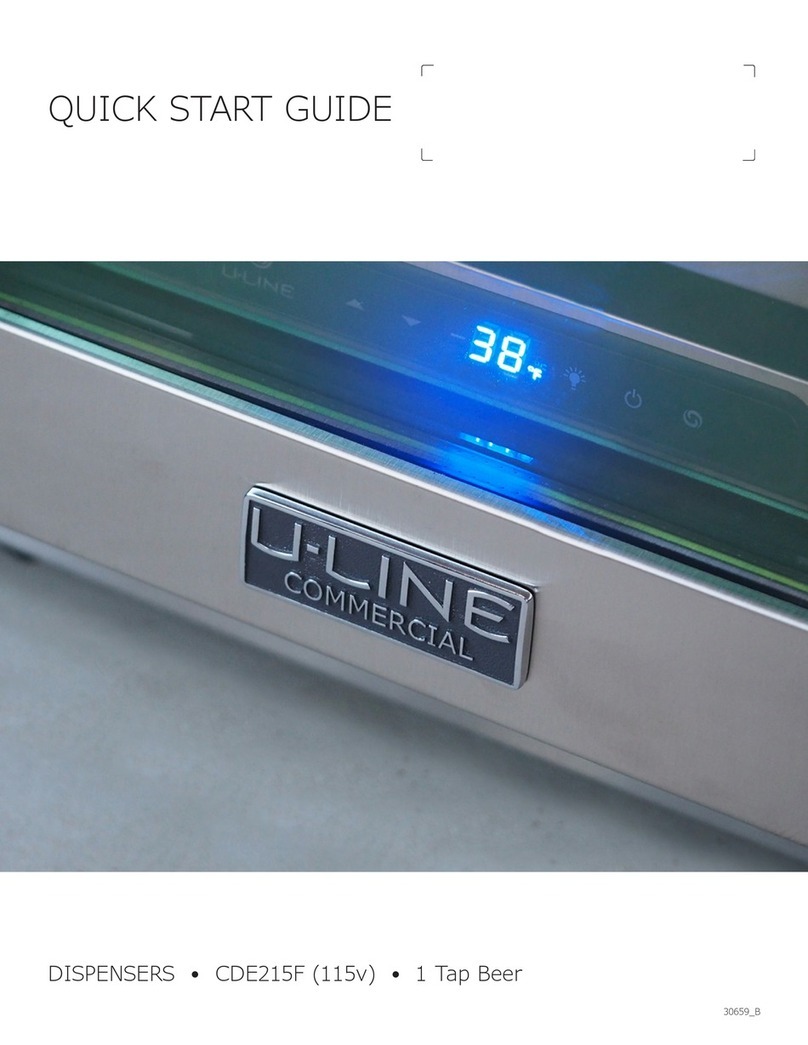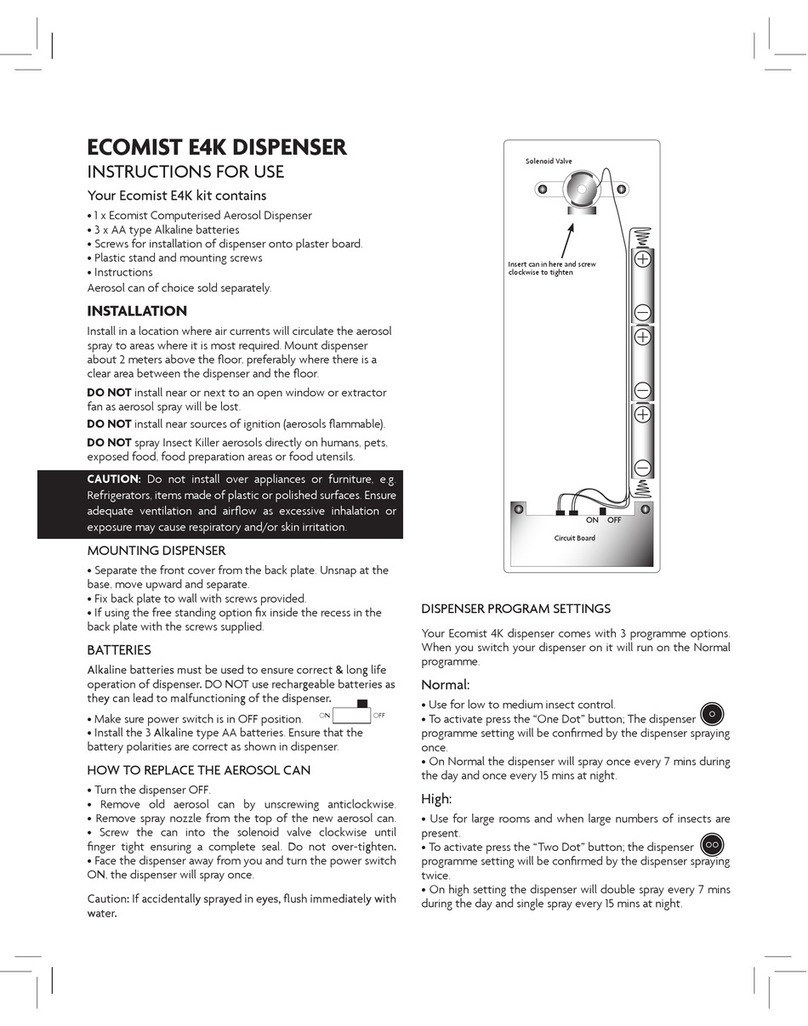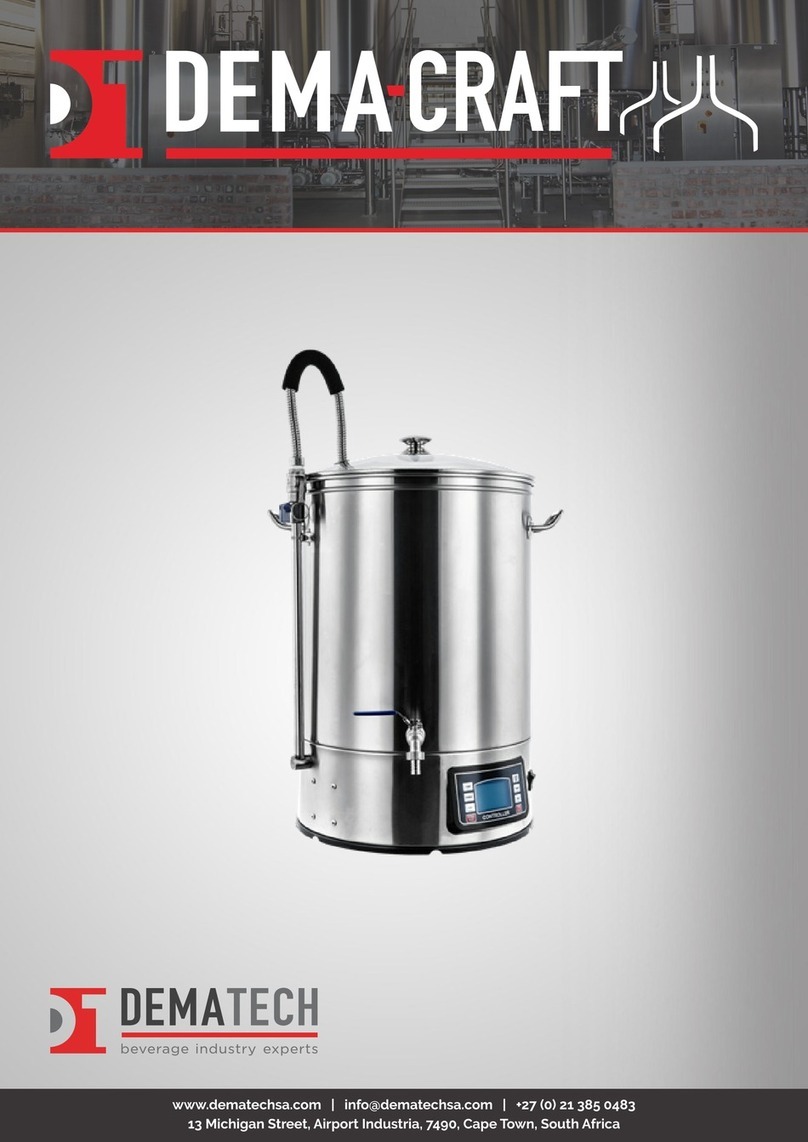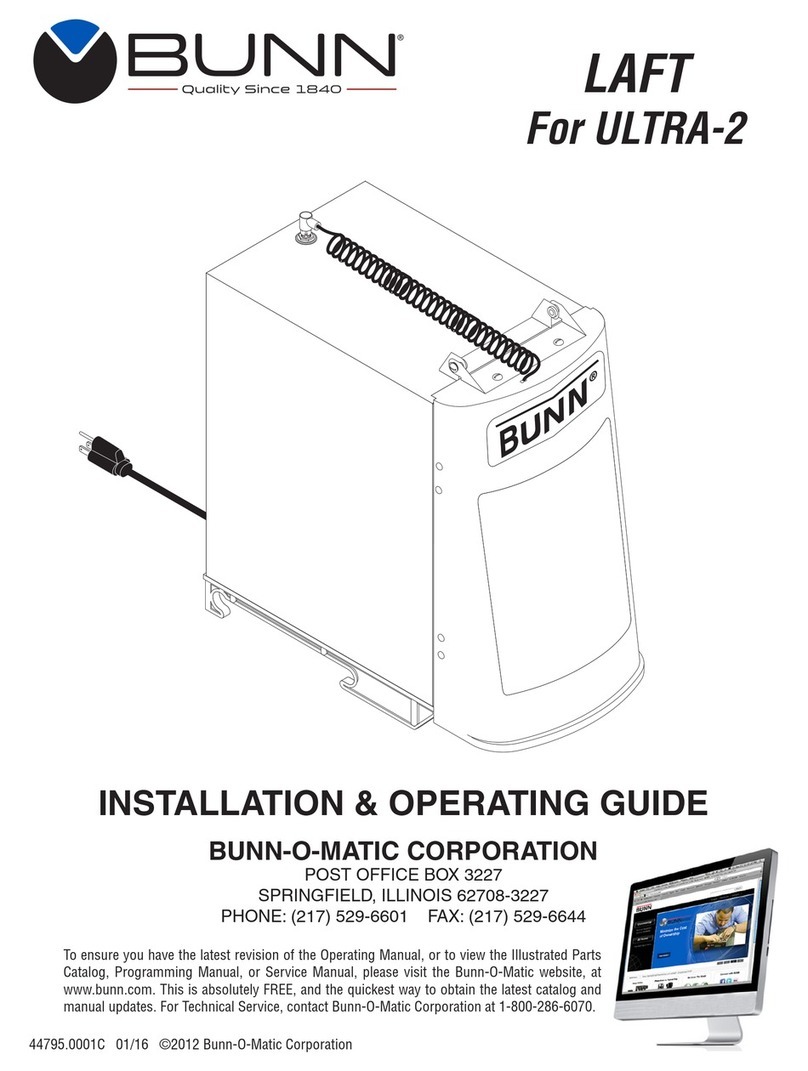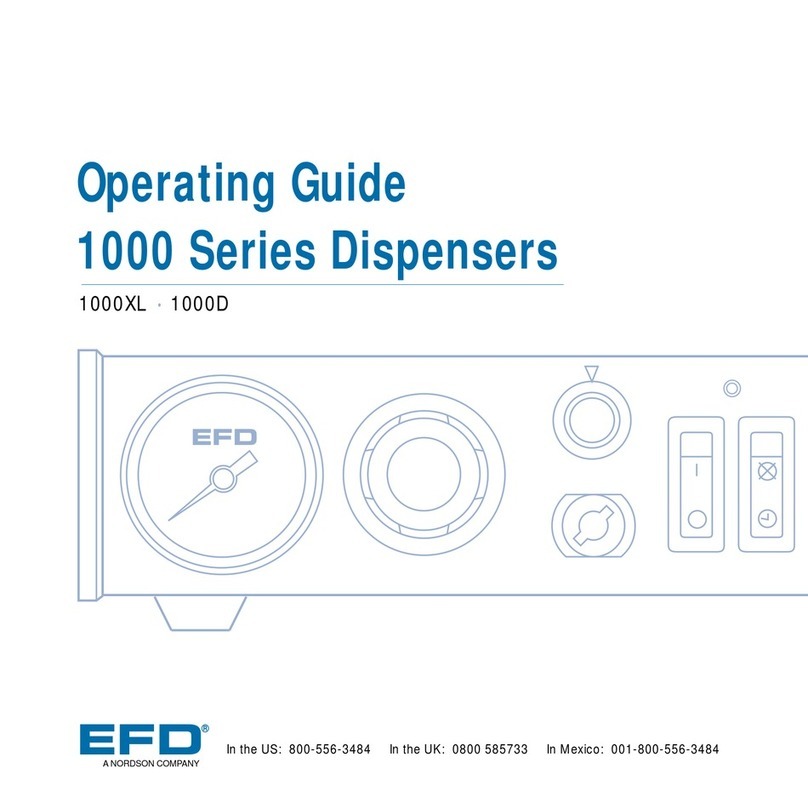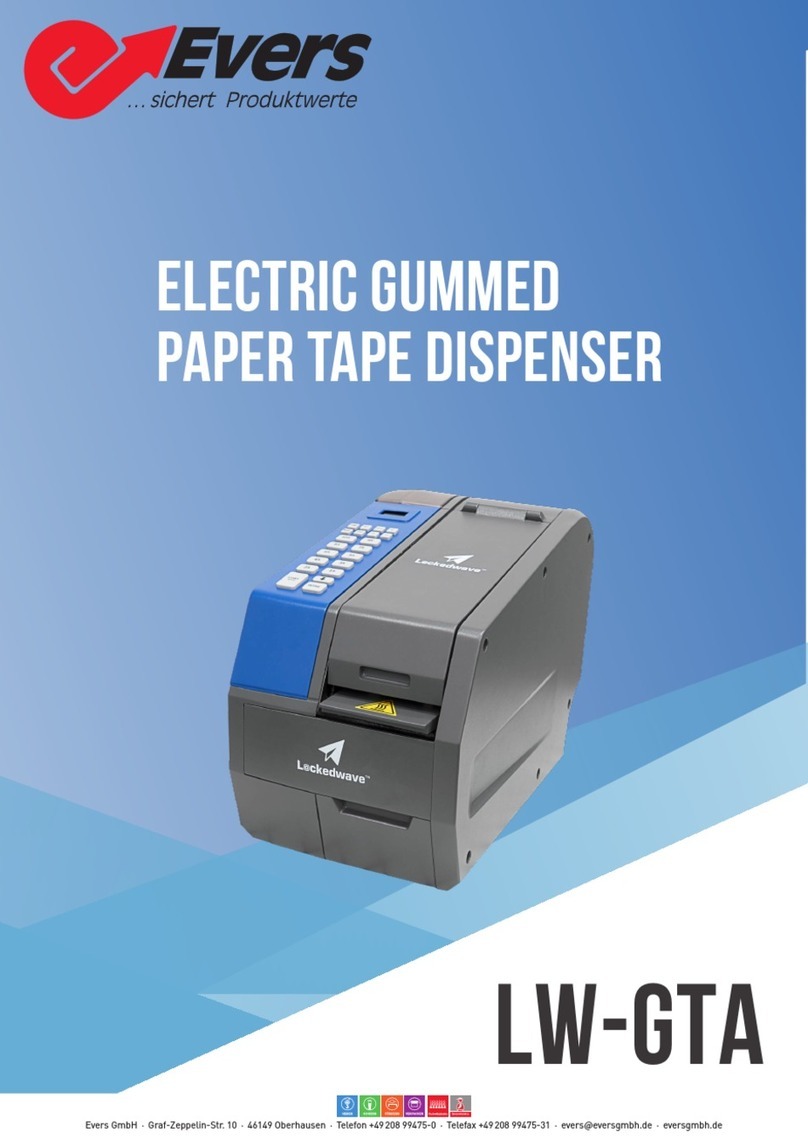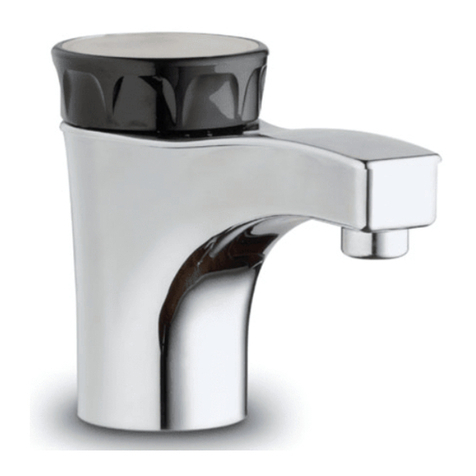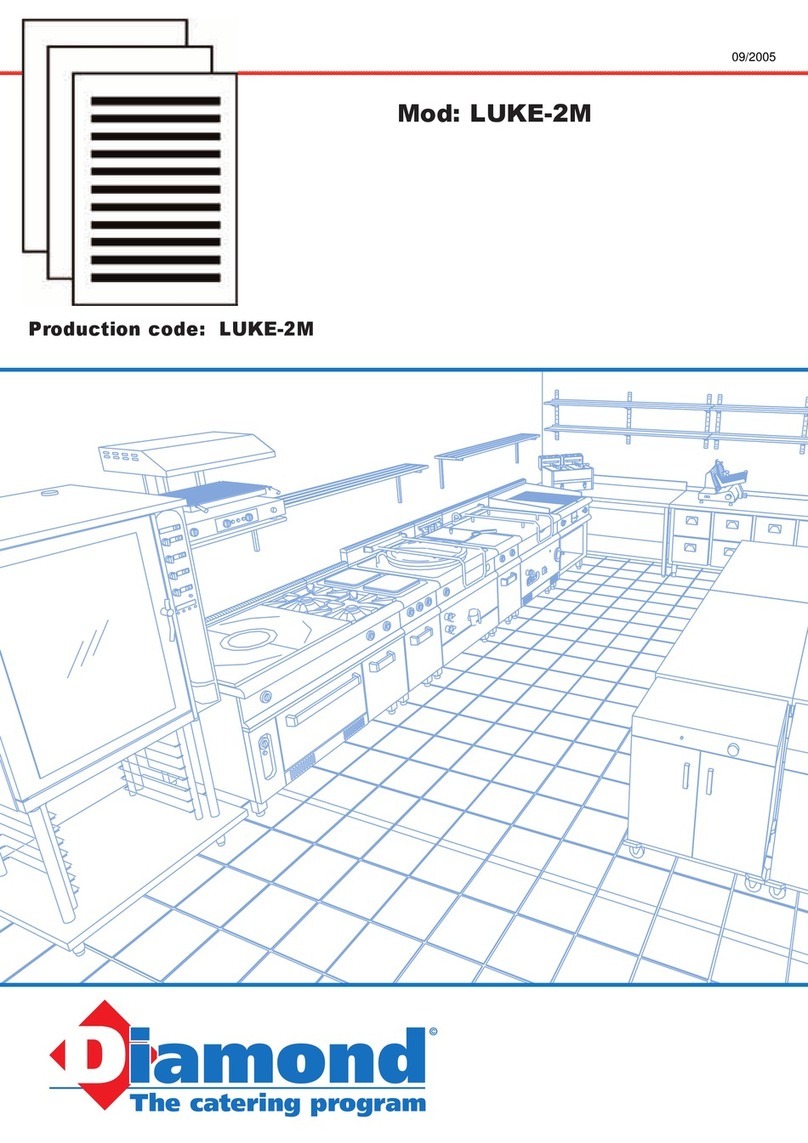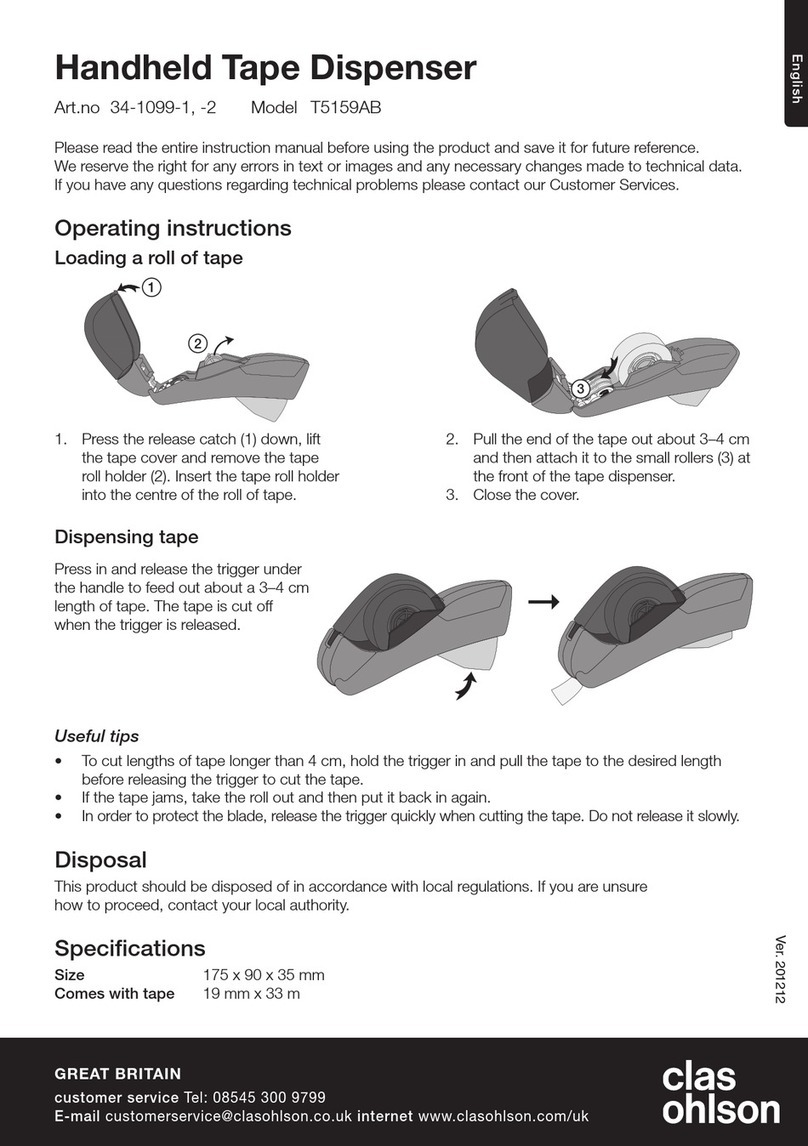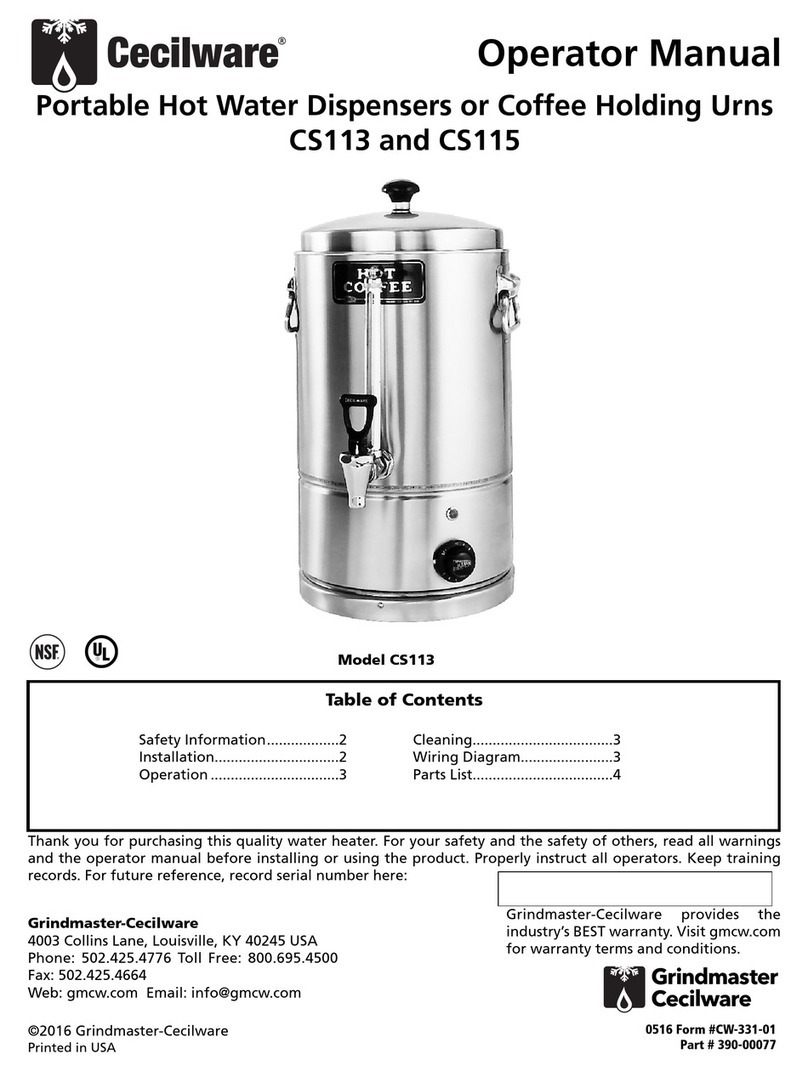BrandTech seripettor User manual

Liquid Handling · Easy Handling!
Gebrauchsanleitung
FIRST CLASS·BRAND
3
Operating Manual
27
Mode d'emploi
51
Instrucciones de manejo
75
Istruzioni per l'uso
99
seripettor®

English
Table of Contents
27
Page
Safety Instructions 28
Functions and Limitations of Use 29
Dispenser Selection Chart 31
Operating Elements 32
First Steps 33
Assembly 33
Priming the instrument 35
Dispensing 36
Dispensing with flexible discharge tube 37
Error Limits (Nominal Volume, Partial Volume) 38
Checking the Volume (Calibration) 39
Cleaning 40
Cleaning/replacing valves 41
Maintenance 43
Replacing the dispensing cartridge 43
Autoclaving 44
Preparations for sterile operation 44
Ordering Information · Accessories · Spare Parts 45
Troubleshooting 48
Repairs · Contact Addresses 49
Warranty Information · Disposal 50

28
Safety Instructions
This instrument may sometimes be used with hazardous materials, operations, and equipment. It is beyond
the scope of this manual to address all of the potential safety risks associated with its use in such applica-
tions. It is the responsibility of the user of this instrument to consult and establish appropriate safety and
health practices and determine the applicability of regulatory limitations prior to use.
1. Every user must read and understand this
operating manual before operation.
2. Follow general instructions for hazard preven-
tion and safety instructions; e.g., wear protec-
tive clothing, eye protection and gloves.
3. Observe all safety precautions provided by
reagent manufacturers.
4. When dispensing flammable media, make pro-
visions to avoid electrostatic charging, e.g., do
not dispense into plastic vessels; do not wipe
instruments with a dry cloth.
5. Use the instrument only for dispensing liquids,
with strict regard to the defined limitations of
use and operating limitations.
Observe operating exclusions (see page 30)! If
in doubt, contact the manufacturer or supplier.
6. Always use the instrument in such a way
that neither the user nor any other person is
endangered. When dispensing, the discharge
tube must always point away from you or any
other person. Avoid splashes. Only dispense
into suitable vessels.
7. Never press down the piston when the dis-
charge tube closure/screw cap is attached.
8. Secure the piston lock during operation.
9. Never remove the discharge tube while the
dispensing cylinder is filled.
10. Reagents can accumulate in the closure cap/
screw cap of the discharge tube. Thus, it
should be cleaned regularly.
11. For small bottles, and when using the flexible
discharge tube, use a bottle stand to prevent
tipping over.
12. Never carry the mounted instrument by the
pump assembly or the valve block (see page
34). Breakage or loosening of the cylinder may
lead to personal injury from chemicals.
13. Never use force on the instrument. Use
smooth gentle movements to operate the
piston downwards.
14. Use only original manufacturer's accessories
and spare parts. Do not attempt to make any
technical alterations. Do not dismantle the
instrument any further than is described in the
operating manual!
15. Always check the instrument for visible dam-
age before use. If there is a sign of a potential
malfunction (e.g., piston difficult to move,
sticking valves or leakage), immediately stop
dispensing. Consult the 'Troubleshooting' sec-
tion of this manual (see page 48), and contact
the manufacturer if needed.
Please read the following carefully!
!

seripettor®seripettor®
pro
English
29
Functions and Limitations of Use
When the instrument is correctly used, the dispensed liquid comes into contact with only the following
chemically resistant materials:
seripettor®:FEP, PP, PE, EPDM
seripettor®
pro
:PP, PE, Borosilicate glass, AI2O3ceramic, ETFE, PFA, FEP, PTFE, Pt-Ir
The bottle-top dispenser seripettor®is designed for dispensing liquids directly from the reservoir bottle
and is offered in two models: seripettor®and seripettor®
pro.
This instrument is designed for dispensing liquids,
observing the following physical limits:
– use between +15 °C and +40 °C (59 °F and
104 °F) of instrument and reagent
(seripettor®: agar culture media up to 60 °C)
– vapor pressure up to 500 mbar
– kinematic viscosity:
2 ml instrument: 300 mm2/s
10 ml instrument: 150 mm2/s
25 ml instrument: 75 mm2/s
(dynamic viscosity [mPas] =
kinematic viscosity [mm²/s] x density [g/cm³])
– density up to 2.2 g/cm3
Limitations of Use Operating Limitations
Liquids, which form deposits may accelerate wear
on the piston seal, and make the piston difficult
to move or may cause jamming (e.g., crystallizing
solutions or concentrated alkaline solutions).
When dispensing inflammable media, make sure
to avoid to buildup of static charge, e.g., do not
dispense into plastic vessels; do not wipe instru-
ments with a dry cloth.
The seripettor®is designed for general laboratory
applications. Compatibility of the instrument for a
specific application (e.g., trace material analysis,
food sector etc.) must be checked by the user.
Approvals for specific applications, e.g. for produc-
tion and administration of food, pharmaceuticals
and cosmetics are not available.

30
Functions and Limitations of Use
Recommended Application Range
For guidelines on selecting the right dispenser ob-
serve the corresponding operating exclusions and
the "Dispenser selection chart" on the next page.
Note:
seripettor®
– Aqueous solutions
Routinely used biological buffer solutions and
detergents, antifoaming agents, culture media,
vitamin solutions etc., as well as hydrogen per-
oxide can be dispensed.
Agar culture media can be dispensed at up to
a max. of 60 °C (140 °F).
–Acids
Weak, dilute or non-oxidizing acids can be
dispensed.
–Alkaline solutions
For dispensing of alkaline solutions, such as
NaOH, KOH and ammonia.
–Polar solvents
E.g., ethanol, methanol, acetylacetone, etc.
seripettor®
pro
:
The seripettor®
pro
bottle-top dispenser extends
the operating range to include the dispensing of
–Acids such as concentrated HCl
–Polar solvents such as acetone
–UV-sensitive reagents
Store the instrument and accessories only in cleaned condition in a cool and dry place.
Storage temperature: from -20 °C to +50 °C (to -4° F to 122° F).
Storage Conditions
seripettor®never use with:
– liquids attacking FEP, PP, PE or EPDM
– non-polar solvents like hydrocarbons and
halogenated hydrocarbons
– concentrated or oxidizing acids
– explosive liquids (e.g., carbon disulfide)
Operating Exclusions
seripettor®
pro
never use with:
– liquids attacking PP, PE, AI2O3ceramic, ETFE,
FEP, PFA and PTFE (e.g., dissolved sodium
azide*)
– liquids attacking borosilicate glass
(e.g., hydrofluoric acid)
– liquids which are decomposed catalytically by
platinum-iridium (e.g., H2O2)
– non-polar solvents like hydrocarbons and
halogenated hydrocarbons
– concentrated or oxidizing acids (excluding HCl)
– explosive liquids (e.g., carbon disulfide)
– suspensions as solid particles may clog or
damage the instrument (e.g., of charcoal)
* Dissolved sodium azide permitted up to a concentration
of max. 0.1%.

English
31
Dispenser Selection Chart
The above recommendations reflect testing completed prior to publica-
tion. Always follow instructions in the operating manual of the instru-
ment as well as the reagent manufacturer‘s specifications. In addition
to these chemicals, a variety of organic and inorganic saline solutions
(e.g., biological buffers), biological detergents and media for cell cul-
ture can be dispensed. Should you require information on chemicals
not listed, please feel free to contact BRAND. Status as of: 0516/8
seripettor®and seripettor®
pro
are not suitable for
hydrofluoric acid (HF)!
Medium seripettor®seripettor®
pro
Acetaldehyde +
Acetic acid, 5% + +
Acetic acid, 96% +
Acetic acid (glacial), 100% +
Acetone +
Acetonitrile +
Acetophenone +
Acetylacetone + +
Acrylic acid +
Acrylonitrile +
Adipic acid + +
Agar (60 °C) +
Allyl alcohol + +
Aluminium chloride + +
Amino acids + +
Ammonia, 30% + +
Ammonium chloride + +
Ammonium fluoride + +
Ammonium sulfate + +
Amyl alcohol (Pentanol) + +
n-Amyl acetate +
Aniline +
Barium chloride + +
Benzaldehyde +
Benzyl alcohol +
Benzylamine +
Benzylchloride +
Boric acid, 10% + +
Butanediol + +
1-Butanol +
Butylamine +
n-Butyl acetate +
Calcium carbonate + +
Calcium chloride + +
Calcium hydroxide + +
Calcium hypochlorite +
Chloroacetaldehyde, 45% +
Chloroacetic acid +
Chromic acid, 50% +
Copper sulfate + +
Cumene (Isopropyl benzene) +
Diethylene glycol + +
Dimethyl sulfoxide (DMSO) +
Dimethylaniline +
Ethanol + +
Formaldehyde, 40% + +
Formamide + +
Formic acid, 100% +
Glycerol + +
Medium seripettor®seripettor®
pro
Glycol (Ethylene glycol) + +
Glycolic acid, 50% + +
Hexanoic acid + +
Hexanol +
Hydriodic acid + +
Hydrobromic acid +
Hydrochloric acid, 37 % +
Hydrogen peroxide, 35% +
Isoamyl alcohol +
Isobutanol + +
Isopropanol (2-Propanol) + +
Lactic acid + +
Methanol + +
Methyl benzoate +
Methyl ethyl ketone +
Methyl propyl ketone +
Mineral oil (Engine oil) +
Monochloroacetic acid +
Nitric acid, 10% +
Oxalic acid + +
Perchloric acid +
Phenol +
Phosphoric acid, 85% +
Piperidine +
Potassium chloride + +
Potassium dichromate + +
Potassium hydroxide + +
Potassium hydroxide in ethanol + +
Potassium permanganate + +
Propionic acid + +
Propylene glycol (Propanediol) + +
Pyridine +
Pyruvic acid + +
Salicylaldehyde +
Salicylic acid + +
Silver acetate + +
Silver nitrate + +
Sodium acetate + +
Sodium chloride + +
Sodium dichromate + +
Sodium fluoride + +
Sodium hydroxide, 30% + +
Sodium hypochlorite, 20 %
(Active chlorine approx. 10 %) +
Sulfuric acid, 10% + +
Tartaric acid +
Urea + +
Zinc chloride, 10% + +
Zinc sulfate, 10% + +

32
Operating Elements
Pump assembly
Piston lock
Volume
adjustment
Dispensing cartridge
(piston, cylinder)
Valve block
Discharge
tube
Stopper cap
Filling tube
Discharge tube
with integrated
valve
Adapter for
discharge tube
Screw cap

2a
1
2c
2b
English
First Steps
33
Wear protective clothing, eye protection and gloves! Follow all safety
instructions and observe limitations of use and operating limitations
(pages 28-30).
Check the discharge tube for a tight fit.
After two days tighten up the locking
nut(s).
Note:
Warning:
Assembly
Adapters for bottle thread Filling tube length
seripettor®GL 32-33, GL 38, S 40 250 mm
seripettor®
pro
GL 32-33, GL 38, S 40 125 - 240 mm
Is everything in the package? Confirm that your package includes:
seripettor®:
Pump assembly seripettor®, valve block with discharge tube (pre-assembled), filling tube, 2x dispensing
cartridge, 3x bottle adapters (PP) and this operating manual.
seripettor®
pro:
Pump assemblx seripettor®pro, valve block with discharge tube (pre-assembled), telescoping filling tube,
2x dispensing cartridge, 3x bottle adapters (PP), mounting tool and this operating manual.
2. Mount pump
assembly
Screw dispensing cartridge into valve
block (Fig.1).
1. Unscrew dispens-
ing cartridge
a) Open piston lock on the pump as-
sembly (Fig. 2a).
b) Put pump assembly over the dispens-
ing cartridge and screw it down to the
valve block (Fig. 2b).
c) Depress pump assembly up to the
lower stop and keep holding it using
one hand and with the other hand,
close piston locking on the pump as-
sembly (Fig. 2c).
d) Release pump assembly and check
to see whether the piston in the dis-
pensing cartridge has moved upward.

5
3
4
3'
34
4. Mounting the
instrument on
a bottle
5. Transporting the
instrument
For bottles with other thread sizes,
select a suitable adapter (Accessories,
page 45).
Note:
When mounted to a reagent bottle,
always carry the instrument as shown
in the figure (fig. 5) and always store it in
the upright position!
Screw the instrument (GL 45 thread)
onto the reagent bottle (fig. 4).
To prevent tipping over use a bottle stand
for small bottles.
3. Mounting the
filling tube
seripettor®:
Cut off the filling tube to accommodate
the bottle height, and attach it (fig. 3).
seripettor®
pro:
Adjust the length of the telescopic filling
tube to the bottle height and attach it
(fig. 3').
Always wear protective gloves when
touching the instrument or the bottle,
especially when using dangerous liquids.
Warning:
Assembly (cont.)
First Steps

b
a
!
30 mm
English
35
Before using the instrument for the first time, ensure it is rinsed
carefully and discard the first few samples dispensed. Avoid splashes.
Note:
Never press down the piston when the discharge tube is closed with
the stopper/screw cap. Avoid splashing the reagent! The reagent can
drip out from the discharge tube and stopper cap.
Warning:
Assembly (cont.)
6. Priming the
instrument
a) Hold the discharge tube and loosen
the stopper cap/screw cap (fig. a).
b) To avoid splashes, hold the discharge
tube orifice on the inner wall of a
suitable receiving vessel.
Allow the piston to rise up approx.
30 mm and push it down rapidly until
the lower stop (fig. b).
Repeat this procedure approximately
5 times until the discharge tube is
bubble-free. A few bubbles up to
1 mm in size are permissible.
First Steps

c
a
!
a) Hold the discharge tube and loosen the
stopper cap/screw cap.
b) Hold the discharge tube orifice on the
inner wall of a suitable receiving vessel.
c) Manually press the pump assembly
all the way down and hold it there
(see fig.).
d) Put the receiving vessel beneath the
discharge tube orifice.
e) Loosen the volume selector thumb
screw one-half turn, set the pointer
to the desired volume and then re-
tighten it (see fig.).
2. Dispensing
Dispensing
a) Hold the discharge tube and loosen
the stopper cap/screw cap.
b) Hold the discharge tube orifice on the
inner wall of a suitable receiving ves-
sel.
c) Press the piston down slowly and
steadily without using excessive force
to the lower stop. Then let it rise up
slowly (fig. c).
d) Wipe off the discharge tube against
the inner wall of the receiving vessel.
e) Reattach the stopper cap to the
discharge tube.
Wear protective clothing, eye protection and gloves! Liquid may accu-
mulate in the stopper cap. To avoid splashes dispense slowly. Follow
all safety instructions and observe limitations of use and operating
limitations (pages 28-30).
Warning:
1. Setting the volume
36
Note:
When setting the volume, liquid will be dispensed!

a
d
c
English
For serial dispensing the optional flexible discharge tube can be used (see 'Accessories' page 46).
The specified accuracy and coefficient of variation of the instrument are only obtained for volumes > 2 ml
and by gently approaching the upper and lower stops. The coil of the tubing can be stretched to a length
of the 800 mm max. The entire coil must lie in regular loops and must not be twisted.
The parts in contact with the media are made of: borosilicate glass, AI2O3ceramic, ETFE, PTFE,
platinum-iridium, PP.
Therefore, never use the flexible discharge tube for:
– liquids attacking borosilicate glass (e.g., hydrofluoric acid)
– Peroxides, as they are decomposed catalytically by platinum-iridium (e.g., H2O2)
Additionally the operating exclusions of the instrument apply.
Warning:
There should be no visible damage to the discharge tube (e.g., kinks
or the like). Each time you are going to use the tubing, examine it
carefully! To dispense aggressive liquids, you should take safety mea-
sures in addition to the normal precautions. We recommend use of a
protective shield. The bottle must be supported using a bottle stand.
To help avoid reagent splashing from the tube, always grip the tube
firmly by the handle and replace into the holder after use. For clean-
ing rinse the tube carefully. Do not dismantle!
Dispensing with flexible discharge tube
a) Attach the tube holder onto the valve
block and mount the receiver tube
(fig. a).
b) seripettor®: prior to mounting the
flexible discharge tube, remove the
installed elastomer sealing ring and
replace it with the accompanying
PTFE-sealing ring.
c) Check whether the gasket is properly
seated in the adapter (fig. c)!
d) Slide the discharge tube onto the
adapter and firmly finger-tighten the
locking nut. Then, slide the adapter
onto the valve block and firmly finger-
tighten the locking nut.
Use a bottle stand (fig. d).
Mounting the flexible
discharge tube
37

Error Limits
Error limits related to the nominal capacity (= maximum volume)
indicated on the instrument, obtained when instrument and distilled
water are equilibrated at ambient temperature (20 °C/68 °F). Testing
takes place with a completely filled instrument and with uniform and
smooth dispensing.
Nominal volume
ml
A* ≤±
% µl CV* ≤
%µl
2 1.2 24 0,2 4
10 1.2 120 0,2 20
25 1.2 300 0,2 50
* A = Accuracy, CV = Coefficient of Variation
Error limits seripettor®/ seripettor®
pro
!20 °C
Ex
38
e.g. Volume A* ≤±
% µl CV* ≤
%µl
VN10 1.2 120 0,2 20
VT= 50% N 5 2.4 120 0,4 20
VT= 10% N 1 12 120 2,0 20
Note:
The maximum error limit for a single measurement can be calculated
EL = A + 2 CV (e.g. for volume 10 ml: 120 µl + 2 x 20 µl = 160 µl).
Partial volume
The percentage values for A and CV are relative to the nominal volu-
me (VN) and must be converted for partial volumes (VT).
VN
VT
AT= · AN
* A = Accuracy, CV = Coefficient of Variation

English
Checking the Volume (Calibration)
Depending on use, we recommend that gravimetric testing of the instrument be carried out every
3-12 months. This time frame should be adjusted to correspond with individual requirements.
Gravimetric volume testing according to DIN EN ISO 8655-6 (for measurement conditions,
see 'Error Limits', page 38) is performed as follows:
39
* Calculation of accuracy (A %) and coefficient of variation (CV %):
A % and CV % are calculated according to the formulas for statistical control.
xi= results of weighings
n = number of weighings
Z = correction factor
(e.g., 1.0029 µl/mg at 20 °C, 1013 hPa)
V0= nominal volume
Mean volume
V – V0
V0
A% = · 100
Σ(xi– x) 2
n – 1
s= Z ·
Mean value x = Σxi
nMean volume V = x · Z
Accuracy* Standard deviation Coefficient of variation*
100 s
V
CV% =
1. Preparation of the instrument
Clean the instrument (Cleaning, page 40), fill it
with distilled H2O and then prime it carefully.
2. Check the volume
a) 10 dispensing operations with distilled H2O in
3 volume ranges (100 %, 50 %, 10 %) are
recommended.
b) For discharge depress piston slowly and
steadily without force until the lower stop.
c) Wipe off the tip of discharge tube.
d) Weigh the dispensed quantity on an analytical
balance. (Please follow the operating manual
of the balance manufacturer.)
e) Calculate the dispensed volume. The Z factor
takes account of the temperature and air
buoyancy.
3. Calculations

2
Cleaning
1. Screw the instrument onto an empty bottle and empty it com-
pletely by dispensing.
2. Screw the instrument onto a bottle filled with a suitable cleaning
agent (e.g., deionized water) and rinse the instrument several
times by completely filling and emptying it.
The cylinder, valves, filling tube and discharge tube contain reagent! Never remove the discharge tube
while the dispensing cylinder is filled. Point the valves and tube openings away from your body. Wear
protective clothing, eye protection and appropriate hand protection.
Warning!
■immediately when the piston is difficult
to move
■before changing the reagent
■prior to long term storage
■prior to dismantling the instrument
■prior to changing the valve
The instrument must be cleaned in the following situations to assure correct operation:
■prior to autoclaving
■regularly when using liquids which form
deposits (e.g., crystallizing liquids)
■regularly when liquids accumulate in the
stopper cap
40

1b
1c
1f
2e
English
Cleaning
41
Cleaning / replacing valves
seripettor®
1. Filling valve
a) Pull out the filling tube.
b) Use a coin to unscrew the filling valve (fig. 1b) and remove
the filling valve body.
c) If the sealing ring is contaminated or damaged, carefully
remove it with a pair of curved forceps (fig. 1c).
d) If necessary, clean any contaminated individual parts
(e.g., in an ultrasonic bath).
e) Insert cleaned or new sealing ring.
f) Screw in the clean or replacement filling valve, first by hand,
and then tighten it with a coin (fig. 1f).
2. Discharge valve
a) Loosen the discharge tube locking nut.
b) Remove the discharge valve.
c) If the sealing ring is contaminated or damaged, carefully
remove it with a pair of curved forceps.
d) If necessary, clean any contaminated individual parts
(e.g., in an ultrasonic bath).
e) Mount the discharge tube with cleaned or new discharge valve
(fig. 2e).

1b
1c
1f
2b
Note:
If the instrument does not fill up, and if some elastic resistance is
evident when the piston is pulled upward, then it is possible that the
ball valve is merely stuck.
In this case, loosen the ball valve using light pressure, for example,
with a 200 µl plastic pipette tip (see fig.).
Cleaning
42
Cleaning / replacing valves (cont.)
seripettor®
pro
1. Filling valve
a) Pull out the filling tube.
b) Use the mounting tool to unscrew the filling valve (fig. 1b).
c) If the sealing ring is contaminated or damaged, carefully
remove it with a pair of curved forceps (fig. 1c).
d) If necessary, clean any contaminated individual parts
(e.g., in an ultrasonic bath).
e) Insert cleaned or new sealing ring.
f) Screw in the cleaned or replacement filling valve, first by
hand, and then tighten it with the mounting tool (fig. 1f).
2. Discharge valve
The discharge valve is integrated in the discharge tube.
a) Remove the discharge tube and clean it in the ultrasonic bath
if necessary.
b) Mount cleaned or new discharge tube (fig. 2b).

3
4
5
2
English
The dispensing cartridge is a wearing part. Replace the cartridge when the piston is difficult to move
or is not airtight.
To prevent chemical injury, the dispensing cartridge has to be cleaned prior to replacement (page 40).
Replacing the dispensing cartridge
1. Screw the instrument onto an empty bottle, and empty it com-
pletely with several dispensings.
2. Manually press the pump assembly all the way down and hold it
there. Loosen the volume selector thumb screw one-half turn,
slide the pointer vertically to the upper stop and then retighten
the volume selector thumb screw (fig. 2).
3. Loosen the piston lock (fig. 3).
4. Unscrew and remove the pump assembly (fig. 4).
5. Unscrew the dispensing cartridge (fig. 5) and replace it with a
new one (Accessories, page 45).
6. Screw the pump assembly on and secure the piston lock.
Maintenance
43

5
1
6
Autoclaving
Both the seripettor®and seripettor®
pro
instruments are autoclavable without pump assembly and dis-
pensing cartridge at 121 °C (250 °F), 2 bar absolute (30 psi) with a holding time of at least 15 minutes
according to DIN EN 285.
44
1. Unscrew the pump assembly and dispensing cartridge
(see page 43).
2. Close the valve block loosely with the closure cap
(Accessories, page 47).
3. Insert the autoclavable filling tube with the sealing ring at the up-
per end into the filling valve (Accessories, seripettor®filling tube,
page 47).
4. Loosely screw the closed valve block with the filling tube and
discharge tube onto the filled bottle.
5. Close the air vent opening with an autoclavable membrane filter
(0.2 µm) (fig. 5).
6. Open the discharge tube and loosen the locking nut (fig. 6).
7. Autoclave.
After autoclaving, the instrument should be used only after it has
reached room temperature.
(Exception: seripettor®with agar culture media up to 60 °C).
1. After autoclaving, close the discharge tube and tighten
the screw coupling (fig. 1).
2. Remove the closure cap in a clean bench hood.
3. Screw in the sterile dispensing cartridge (Accessories, page 45).
4. Fasten the pump assembly.
Note:
It is the user's responsibility to ensure effective autoclaving.
Preparations for sterile operation

English
Ordering Information · Accessories · Spare Parts
45
seripettor®
Capacity
ml
Subdivision
ml
A*
≤ ± % µl
CV*
≤ %µl
Cat. No.
0.2 - 2 0.04 1.2 24 0.2 4 4720 120
1 - 10 0.2 1.2 120 0.2 20 4720 140
2.5 - 25 0.5 1.2 300 0.2 50 4720 150
seripettor®
pro
Capacity
ml
Subdivision
ml
A*
≤ ± % µl
CV*
≤ %µl
Cat. No.
0.2 - 2 0.04 1.2 24 0.2 4 4720 420
1 - 10 0.2 1.2 120 0.2 20 4720 440
2.5 - 25 0.5 1.2 300 0.2 50 4720 450
* The values of accuracy and coefficient of variation are final test values referring to the
delivered volume, instrument and distilled water at equilibrium with ambient temperature
(20 °C/60 °F) and smooth and steady operation.
A = Accuracy, CV = Coefficient of variation
Bottle adapters, PP.
For seripettor®and
seripettor®
pro
.
Pack of 1.
Description Pack
of
Cat. No.
2 ml, non-sterile 3 7045 00
10 ml, non-sterile 3 7045 02
25 ml, non-sterile 3 7045 04
2 ml, sterile*** 7 7045 07
10 ml, sterile*** 7 7045 06
25 ml, sterile*** 5 7045 08
Dispensing cartridges
For seripettor®and
seripettor®
pro
.
Non-sterile and sterile.
Piston (PE), cylinder
(PP).
Note:
Dispensing cartridges are not autoclavable.
*** individually wrapped
Outer
thread
for bottle thread**/
for ground joint
Cat. No.
GL 32 GL 24-25 7043 25
GL 32 GL 28 / S* 28 7043 28
GL 32 GL 30 7043 30
GL 32 GL 45 7043 45
GL 45 GL 32-33 7043 96
GL 45 GL 35 7044 31
GL 45 GL 38 7043 97
GL 45 S* 40 7043 43
GL 45 S* 54 7044 30
S* 40 S* 60 7043 48
GL 32 19/26 7044 19
GL 32 24/29 7044 24
GL 32 29/32 7044 29
* buttress thread
** GL, S: the specifications correspond to the outer diameter of
bottle thead in mm.
Table of contents

